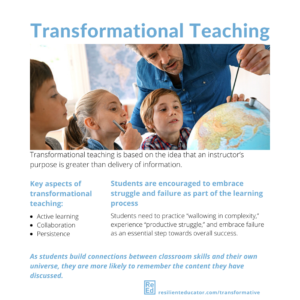
In his 2010 TED talk “Bring on the Learning Revolution,” Sir Ken Robinson suggested that the best evolution in education can be made by moving from a factory-style mechanical model toward an organic model of teaching that adjusts specifically to the people being taught.
Robinson’s criticism of education reform should be noted, but the reality of American public education is Common Core State Standards and curriculum often modified by school boards or molded by textbook publishers. Occasionally, current educational policies even rely upon a model of education that views teachers as a static repository of knowledge to be transmitted to students.
Modern classrooms can and should look different, and they don’t have to wait for the large-scale education revolution that Sir Robinson describes. If teachers embrace a transformational teaching model, Robinson’s organic classroom can be a reality.
Transformational education: a radical shift from old forms of teaching
Transformational teaching is based on the idea that an instructor’s purpose is greater than delivery of information. Rather than being content-focused, transformational teachers help students become meta-critical participants in the learning process and well-practiced at critical thinking, goal setting and reflection.
Inquiry-based learning, service learning, and project-based learning are all forms of transformational education. Teachers who use these methods have a high burden of preparation and flexibility, but the short-term time investment has long-term payoff, particularly when a classroom of learners becomes a tight-knit and engaged community capable of reflecting on their needs and interests as learners.
Modeling and facilitation in transformational learning
Engaging students as active learners is key to transformational learning. Class or small-group discussions built around real-world problems that encourage students to apply their learning and synthesize and empathize with ideas can be incredibly helpful for engaging students as problem solvers.
Students may require some guidance during this work, so transformational teachers should engage in modeling and facilitation to allow student input and creativity while also keeping students engaged in a carefully crafted lesson that guides them toward a larger learning objective.
Modeling should consist of the same skills teachers expect of their students:
- Analysis
- Synthesis
- Interpretation
- Connection
As students build connections between classroom skills and their own universe, they are more likely to remember the content they have discussed.
Key aspects of transformational teaching: active learning, collaboration, persistence
Active classrooms sometimes require collaborative or team-based work in order to address some of the case studies or service projects that make transformative teaching most successful. While some instructional models have a negative view of group work, transmission-style education is unique in its pushback against collaboration.
When students leave the classroom, they will be engaged in a work world that frequently requires group work or someone to act as a team leader. Transformative classrooms push teachers to embrace such work now as a means of preparing students for their collaborative future.
Another key aspect of transformational teaching is the concept of struggle. Recent educational research looks to long-term student success and has identified one of the key traits among those with the highest educational success as persistence.
Students are encouraged to embrace struggle and failure as part of the learning process
To make better learners and thinkers, it is important that students practice “wallowing in complexity,” experience “productive struggle,” and finally embrace failure as an essential step working toward overall success. Students who are accustomed to complexity, struggle, and failure as a part of the educational process are more likely to positively engage with an instructor’s feedback.
Moving from transmission-style education to transformational teaching is a deliberate choice that requires dedication and commitment, but the immediate payoff in student performance is eclipsed by the rewards seen in student engagement.
Active learners are excited to come to class and engage with teachers and their work, and the results of their labor can be world-changing. From teachers who encourage their students to collaborate and create TED talks to those who push their students to become world-changer now, not later, transformational education is part of a learning revolution.
Monica Fuglei is a graduate of the University of Nebraska in Omaha and a current faculty member of Arapahoe Community College in Colorado, where she teaches composition and creative writing.

